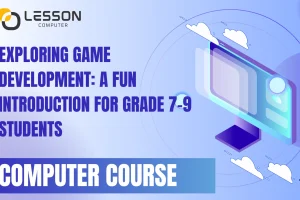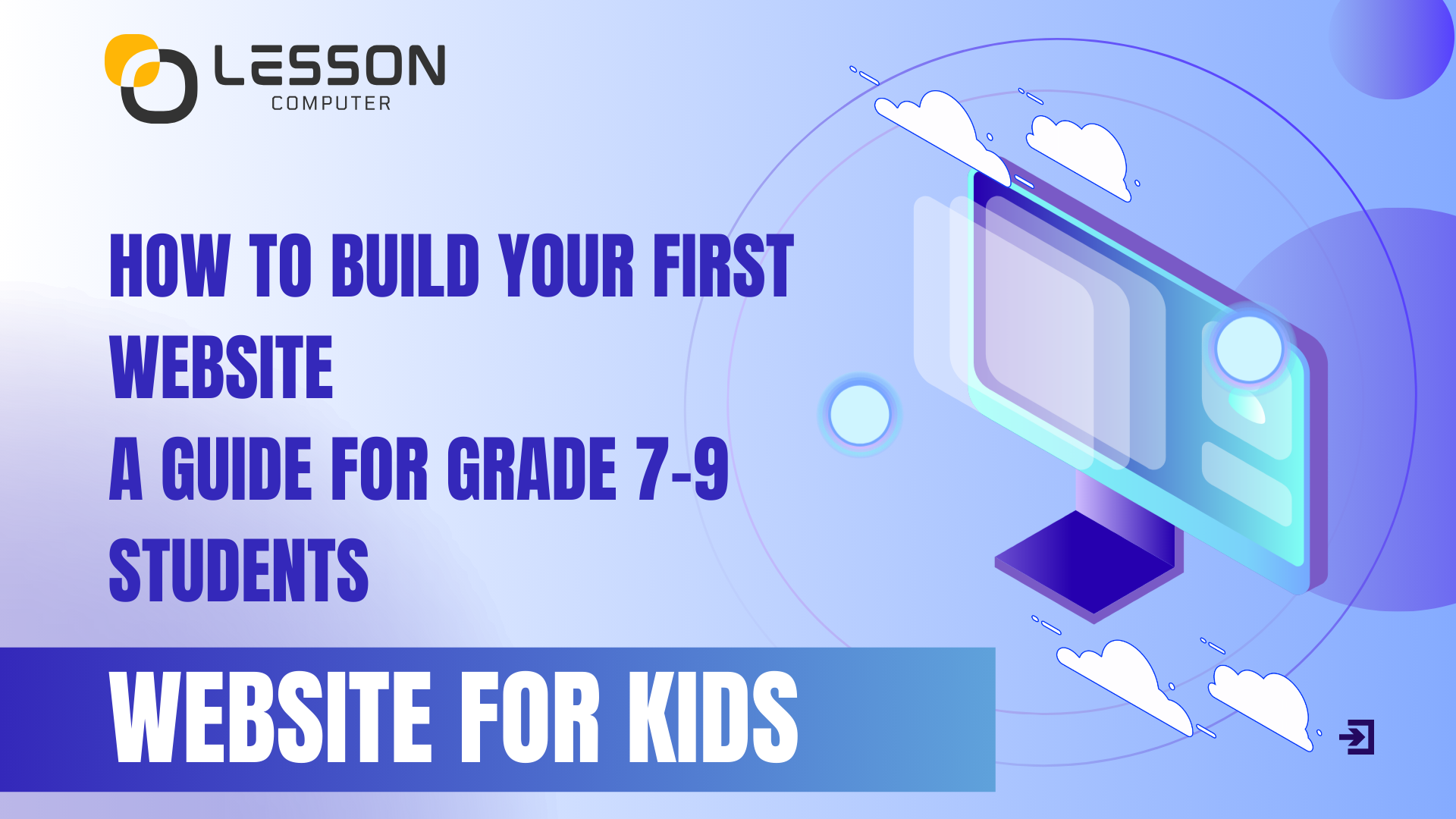
How to Build Your First Website: A Guide for Grade 7-9 Students
Creating your first website can be an engaging and rewarding experience, particularly for students in grades 7 to 9. With some basic guidance, it is possible to establish a personal online presence where you can display your interests, hobbies, or school projects. This guide aims to simplify the process by breaking it down into manageable steps, ensuring that website creation remains an enjoyable and accessible endeavor.
1. Understanding What a Website Is
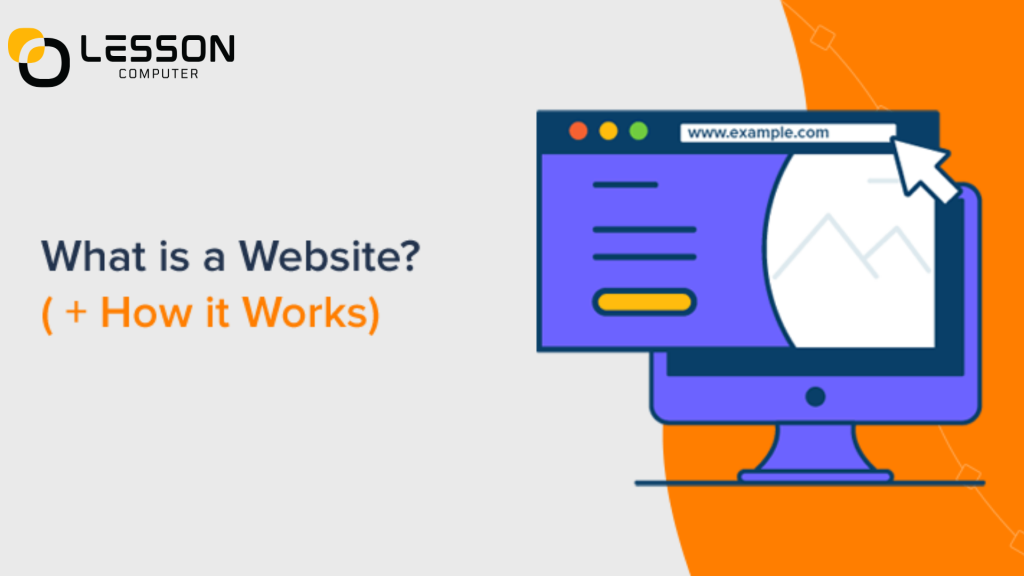
Before diving in, let’s take a moment to explore what a website truly is and how it functions. Understanding these fundamentals sets the stage for an exciting journey into the digital world!
1). What Is a Website?
A website is a dynamic digital platform designed for sharing a wide array of content, such as information, images, videos, and interactive features. Imagine it as your personal online diary, where you can chronicle your thoughts and experiences, or as a vibrant digital portfolio that showcases your projects and creative endeavors. Visitors to your website can navigate through various sections, each presenting unique insights and visuals that reflect your ideas and interests. This virtual space fosters connectivity, allowing you to engage with a diverse audience and promote your work or message in a visually appealing and easily accessible manner.
2). How Websites Work
A website serves as a unique digital space designed for individuals and organizations to share a wide range of content, including information, images, videos, and interactive elements. Imagine it as your personal online diary where you can express your thoughts, document your experiences, or portray your creative endeavors. Alternatively, you can think of it as a digital project display board that showcases your work, achievements, or hobbies for an audience to explore. Each website consists of various pages linked together, allowing visitors to navigate seamlessly through different topics or sections. With the ability to incorporate multimedia, blogs, and forums, a website can foster communication and interaction with users, making it a versatile platform for personal expression or professional presentation.
2. Picking a Topic or Purpose for Your Website
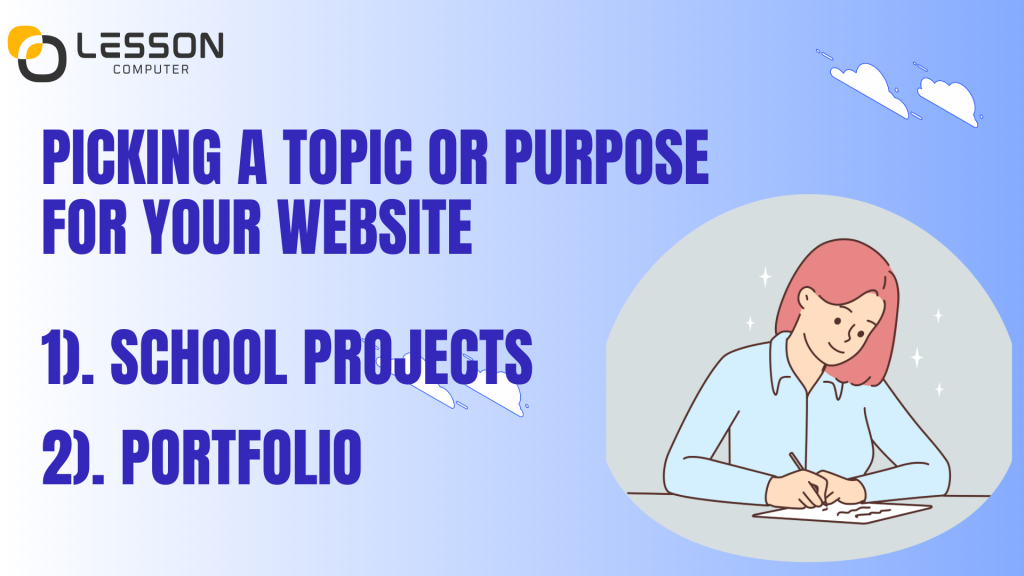
Every website is designed with a specific purpose in mind, whether it’s to inform, sell, or engage. Identifying your website’s unique goal is the crucial first step in your creative journey, guiding you toward effective design and content choices.
1). Personal Blog
If you have a passion for writing about your hobbies or want to share your personal thoughts and experiences, starting a personal blog can be an excellent avenue for self-expression. A blog allows you to capture your interests, whether they involve crafts, travel, cooking, or any other pursuits, and share them with a broader audience. You can explore your creativity while connecting with others who share your interests. Furthermore, maintaining a blog provides a platform for you to document your journey, reflect on your experiences, and engage in meaningful conversations with readers who resonate with your ideas. It’s a fulfilling way to not only articulate your passions but also to build a community around shared interests.
2). School Projects
Design an engaging website to showcase your science project, detailed history timeline, or any school assignment in a creative and innovative manner. Consider incorporating interactive elements such as videos, animations, or diagrams to enhance the learning experience. Utilize visually appealing layouts and graphics to capture attention, and ensure content is organized logically to make it easy for users to navigate. Incorporating features like quizzes, discussion forums, or downloadable resources can also encourage further exploration of the topic. Aim for a user-friendly design that reflects your unique perspective and creativity, making your assignment not just informative but also enjoyable for viewers.
3). Portfolio
Present your artwork, coding projects, or creative writing pieces to demonstrate your skills and creativity to your friends and teachers. This is a great opportunity to highlight your talents and receive valuable feedback.
3. Choosing a Website-Building Platform
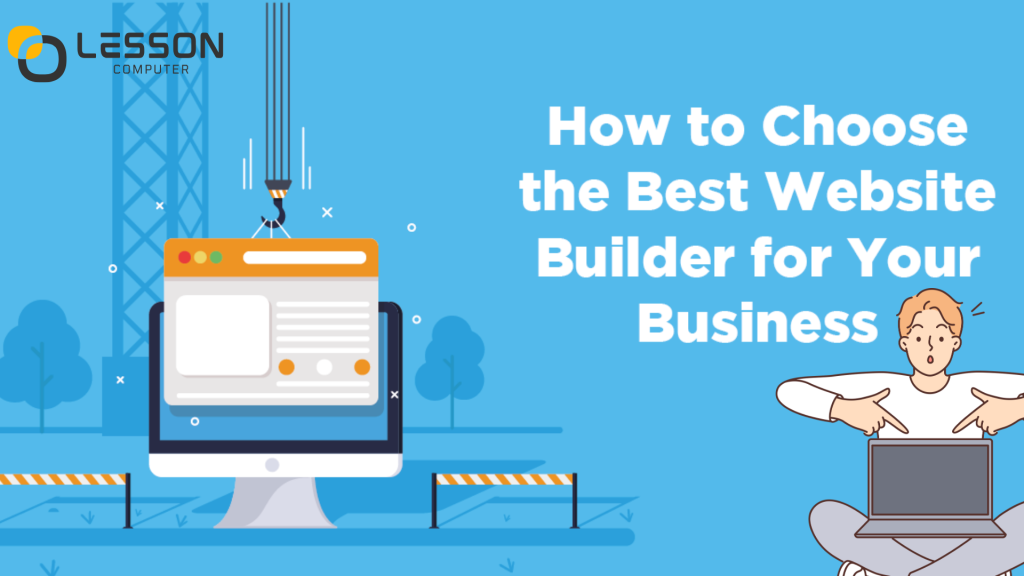
You can build a website without advanced coding skills. Many tools help beginners create websites easily. These platforms offer simple drag-and-drop features, allowing you to add and arrange elements like text, images, and videos without writing code.
They also provide customizable templates for different needs, whether it’s for a blog, an online store, or a portfolio. Moreover, these tools often include helpful features such as search engine optimization, mobile-friendly designs, and social media integration. With these options, you can create a professional website that showcases your ideas and goals.
1). Free Website Builders
Platforms such as Wix, WordPress.com, and Weebly provide user-friendly drag-and-drop tools that make it simple for anyone, regardless of technical expertise, to design and customize their websites. With Wix, users can choose from a wide array of templates and easily rearrange elements like images, text boxes, and buttons to create a unique layout. WordPress.com offers a similar experience, allowing users to utilize various themes and plugins to enhance functionality and aesthetics. Weebly, known for its intuitive interface, guides users through the process of building a site step-by-step, making it accessible for beginners and small business owners looking to establish an online presence without needing coding skills. Each platform empowers users to express their creativity and launch their websites quickly and efficiently.
Here is an overview of the pricing plans for Wix, WordPress.com, and Weebly, providing options for building and managing your website:
| Platform | Plan Name | Monthly Cost | What You Get |
| Wix | Free | $0 | Start for free with a basic site, but you’ll have Wix ads and a subdomain like yourname.wixsite.com. |
| Light | $17 | No more ads! Get 2GB storage, a free custom domain for the first year, and basic tools to grow your site. | |
| Core | $29 | Perfect for small businesses—50GB storage, an online store, and tools to handle up to 25 dropshipping items. | |
| Business | $36 | Scales up for growing businesses with 100GB storage, multi-currency support, and tax automation tools. | |
| Business Elite | $159 | Designed for large businesses with unlimited storage, VIP support, loyalty program tools, and analytics. | |
| WordPress | Free | $0 | A good way to try it out! Includes a subdomain, but customization and storage are very limited. |
| Personal | $4/month | Great for personal blogs with a custom domain and no ads. | |
| Premium | $8/month | Advanced designs and monetization features, plus 13GB storage. | |
| Business | $25/month | Powerful tools like plugin access, 200GB storage, and no ads—ideal for serious bloggers or businesses. | |
| Ecommerce | $45/month | Everything in Business, plus features to sell unlimited products and streamline your store. | |
| Weebly | Free | $0 | Basic features to get started, but your site will show Weebly branding. |
| Personal | $6/month | Affordable entry plan with a custom domain and no ads, plus 500MB storage. | |
| Professional | $12/month | Unlimited storage, search functionality, and custom video backgrounds for a polished look. | |
| Performance | $26/month | Tools for eCommerce, including advanced analytics, email marketing, and priority support. |
2). Learning Basic HTML and CSS\
If you’ve ever wondered how websites function beneath the surface, delving into the basics of coding can be both fascinating and fulfilling. HTML, which stands for Hyper Text Markup Language, serves as the backbone of your website, providing the essential structure that defines the layout and content. On the other hand, CSS, or Cascading Style Sheets, plays a crucial role in enhancing the visual appeal of your site, allowing you to style and arrange elements beautifully. By learning these two fundamental languages, you can gain insight into the creation and design of websites, unlocking the potential to build your own online presence.
4. Planning Your Website’s Structure
A successful website begins with a comprehensive plan. This strategic framework is essential for organizing content and features in a way that enhances user experience. By outlining the site’s structure, you can ensure that visitors can effortlessly navigate through various sections, find the information they are seeking, and engage with the content effectively. Moreover, a solid plan helps in identifying key elements such as target audience, design aesthetics, and functionality, all of which contribute to a seamless user journey that keeps visitors returning.
1). Homepage
What you have to write on your home page. It’s a big confusing question. But I’ll give a simple guide which is more amazing and engaging as well.
Welcome to our website! We are glad you are here. This page gives you a warm welcome and a clear overview of what you will find on our site.
Our site is dedicated to [briefly describe your site’s theme or mission]. You can explore many resources, including [list key features or sections], that meet your interests and needs.
We encourage you to check out different sections and discover the helpful content we offer. Whether you want to learn, connect, or shop, we hope you find what you are looking for. Enjoy your visit!
2). About Page
Feel free to share some information about yourself or the project you’re working on. This could include your background, your interests, the goals of your project, and any challenges you’ve faced or achievements you’ve made. Providing details will help others better understand your perspective and the context of your work.
3). Additional Pages
Based on the objectives of your website, consider incorporating additional pages dedicated to various features, such as a blog section for sharing articles and updates, a gallery to showcase images or artworks, or specific topic pages that delve deeper into particular subjects of interest. This will enhance user engagement and provide visitors with a comprehensive understanding of your content.
5. Designing Your Website
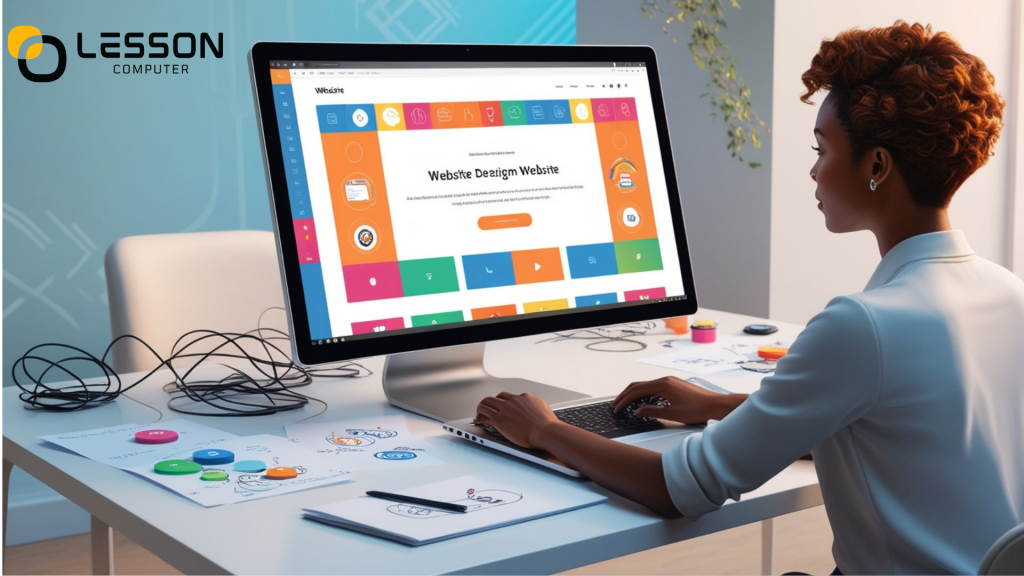
Add pages to your website based on its purpose. Consider including blogs, galleries, or pages for specific topics to engage your audience.
1). Choosing a Theme
Website builders typically provide a variety of pre-made themes designed to suit different styles and purposes. It’s important to select a theme that aligns with the objectives of your website to ensure a cohesive and effective presentation.
5.2 Adding Colors and Fonts
To ensure clear communication, focus on keeping your text simple and easy to read. Avoid using bright colors and fancy fonts too much, as they can make it hard for people to read. Instead, choose a few colors and readable fonts that support your message. This will help your audience understand your content better.
3). Adding Images
When selecting images for your project, prioritize relevance and quality to ensure they effectively enhance your content. You have the option to create your own unique visuals that reflect your style and message, or you can explore a variety of high-quality, free images available on platforms like Unsplash. These resources can provide you with stunning photographs that align with your vision and engage your audience.
6. Writing Content for Your Website
Content serves as the very foundation of your website. It plays a crucial role in engaging and retaining visitors by providing them with valuable information, insights, and experiences. High-quality content not only captures the attention of your audience but also encourages them to explore further, ultimately enhancing their experience. When crafted thoughtfully, it can address their needs, answer their questions, and inspire action, making your website a go-to resource in your niche.
1). Writing for Your Audience
Consider the audience that will be visiting your website. It’s important to tailor your writing style and tone to ensure it’s accessible and relatable for them. Take time to understand their preferences, backgrounds, and levels of familiarity with the subject matter. Use clear and straightforward language, avoiding jargon or overly complex terms. Aim for a friendly and engaging tone that invites visitors in, making them feel comfortable and encouraged to explore your content further. Ultimately, your goal should be to communicate effectively so that your message resonates well with your target audience.
2). Organising Information
To help your audience understand your writing, follow these tips:
Use Headings
- Break up text: Use headings to divide your content into clear sections. This makes it easier for readers to find what they need.
- Guide readers: Headings let readers see what the content covers and help them jump to parts they are interested in.
Use Bullet Points
- Show key details: Bullet points highlight important information. Readers can quickly understand the main points.
- Keep it engaging: Lists make your content look better and easier to read than long paragraphs.
Keep Paragraphs Short
- Make it simple: Use short paragraphs of 2-3 sentences. This prevents overwhelming readers and keeps their attention.
- Improve understanding: Short paragraphs help clarify your ideas and make them easier to follow.
Summary
Using headings, bullet points, and short paragraphs will make your content more readable and enjoyable for your audience.
7. Publishing Your Website
Once you have completed the final touches on your website, the next important step is to actively promote it and share it with a global audience. This is your opportunity to showcase your hard work and connect with visitors who may benefit from your content or services.
1). Picking a Domain Name
A domain name serves as the online address for your website, functioning much like a physical address but in the digital world; for instance, it could resemble something like www.mycoolsite.com. You have the option to select a free domain name, such as mycoolsite.weebly.com, which is often provided by website builders. Alternatively, you can purchase a custom domain name, offering a unique and professional online identity that is tailored specifically to your brand or business..
2). Hosting Your Website
Many website builders come with built-in hosting services, making it easy to get your site up and running without additional setup. However, if you’re looking for more advanced features and greater control over your hosting environment, you might want to consider dedicated hosting platforms like Bluehost. These platforms provide a range of options tailored to various needs, from shared hosting for beginners to more robust solutions for high-traffic sites, along with enhanced security and customer support.
3). Testing Before Publishing
Give your website a friendly makeover! Dive into how it appears on various devices, from smartphones to tablets, to ensure it’s a breeze for users to navigate.
8. Learning Basic Coding Skills
Learning to code gives you control over your website. It allows you to change the design and add features that fit your needs. Coding makes it possible to create a website that matches your ideas perfectly. This process is not just practical; it can also be fun as you explore different coding languages and techniques. Through coding, you can turn your vision into reality while enjoying the creative process.
1). HTML Basics
Discover the fundamentals of HTML by learning how to create various essential elements such as headings, paragraphs, and hyperlinks. Understand the significance of heading tags (like <h1> to <h6>) for organizing content and enhancing readability. Explore how to structure paragraphs with the <p> tag to present your text in a clear and coherent manner. Additionally, delve into the creation of links using the <a> tag, allowing you to connect to other pages or resources on the web effectively. This foundational knowledge will empower you to build well-structured and accessible web content.
2). CSS Styling
Explore and experiment with an extensive range of colors, typography, and various layout designs using CSS. This involves playing with different color palettes to enhance the visual appeal of your website, selecting diverse fonts to improve readability and style, and trying out multiple layout structures to cleverly arrange elements on the page. Don’t hesitate to use CSS properties such as background-color, font-family, and display types to create a unique and engaging user experience.
3). JavaScript Fun
To create a more engaging user experience, consider incorporating interactive elements, specifically buttons that provide visual or auditory feedback when clicked. These buttons can change appearance—such as color or size—upon interaction, signaling to users that their action has been recognized. Additionally, you could implement animations or sound effects to further enhance the feedback, making the interaction more enjoyable. This approach not only improves usability but also encourages users to explore your platform more actively, ultimately leading to increased user retention and satisfaction.
9. Keeping Your Website Updated
A great website changes over time. It updates to meet users’ needs and adapt to new technologies. This means regularly adding fresh content, improving user experience, and including new features that reflect current trends and feedback. By looking at performance data and user behavior, a successful website can enhance its design and usability, keeping it relevant and engaging for visitors.
1). Adding New Content
To ensure your website remains engaging and relevant, it is important to regularly update its content. This can include adding new blog posts that reflect current trends, insights, or topics of interest to your audience. Additionally, refreshing photo galleries with recent images or high-quality visuals can enhance the aesthetic appeal of your site. Consider also updating other sections, such as testimonials, case studies, or service descriptions, to accurately represent your offerings and keep visitors informed. Frequent updates not only captivate your audience but also improve your search engine rankings, making it easier for potential visitors to find your site..
2). Listening to Feedback
Ask your friends or family to look at your website. Have them explore different pages and features. After they review it, ask for their feedback on the design, ease of use, and the clarity of the content. Their opinions can help you see areas that need improvement. Encourage them to suggest specific changes based on their experience.
3). Fixing Errors
To maintain a high standard of quality in your content, it is important to perform thorough checks on several key elements. First, ensure that all hyperlinks direct users to the intended locations without any broken links, as this enhances user experience and trust. Next, confirm that all images load seamlessly and are displayed correctly across various devices and browsers, as this contributes to the visual appeal of your content. Lastly, conduct a comprehensive review for spelling mistakes, as errors can detract from your credibility and professionalism. Taking these steps will help ensure that your content is polished and effective.
10. Exploring Career Opportunities in Web Development
Establishing a website marks only the initial phase of a comprehensive endeavor. It is the foundation upon which you can build an engaging online presence, attract your target audience, and cultivate lasting relationships. From designing a user-friendly interface to optimizing for search engines and ensuring responsive functionality across devices, each subsequent step is crucial in transforming your site into a powerful tool for communication and business growth.
1). Becoming a Web Developer
Learn about the methods and practices that professional developers employ to design and build websites tailored for businesses and organizations.
2). Learning Advanced Tools
As you progress in building your web development skills, it’s essential to explore popular frameworks that can enhance your projects and streamline your workflow. Bootstrap is a front-end framework that allows you to design responsive and mobile-first websites quickly. With its pre-designed components and grid system, you can create visually appealing layouts without starting from scratch. On the other hand, React is a powerful JavaScript library for building user interfaces, particularly for single-page applications. It promotes a component-based architecture, enabling you to create reusable UI elements that can efficiently manage state and handle user interactions. Delving into these frameworks not only improves your coding proficiency but also prepares you for real-world development tasks.
3). Showcasing Your Work
Creating your first website can serve as a crucial launchpad for building a comprehensive portfolio that showcases your skills and talents to potential employers and clients. This initial project not only allows you to apply what you’ve learned about web development and design but also provides a platform to exhibit your creativity and technical abilities. As you curate your online presence, it can lead to a variety of exciting opportunities in the tech industry, such as freelance projects, collaborative ventures, or even full-time positions. By effectively displaying your work, you’ll increase your chances of standing out in a competitive job market and opening doors to a fulfilling career in technology.
Conclusion
As a student in grades 7 to 9, embarking on the journey of creating your first website is an exciting opportunity to delve into the world of technology while nurturing your creativity and developing valuable skills. This project not only allows you to express your unique ideas but also equips you with knowledge that will serve you well in future academic and professional endeavors.
You can choose between user-friendly drag-and-drop website builders, such as Wix or Weebly, which require no coding experience, or dive into more technical aspects by learning HTML, CSS, and JavaScript. Each path offers its own set of benefits—the former provides immediate results and ease of use, while the latter can give you a deeper understanding of how websites function.
Start by gathering your ideas and determining the purpose of your website. What message do you want to convey? Is it a personal blog, an online portfolio, or perhaps a resource center for a specific hobby or interest? Once you have a clear vision, select a platform that aligns with your goals and comfort level.
As you begin to design your site, remember to consider elements such as layout, color schemes, and user navigation. Experiment with different features and functionalities to make your website engaging and user-friendly.
This will not only enhance your technical skills but will also boost your confidence as you see your ideas come to life online. Moreover, the problem-solving skills you develop during this process will be invaluable as you face future challenges in technology.
So, roll up your sleeves, unleash your creativity, and get started on building your website today! The skills and experience you gain will lay a solid foundation for your future in the digital world.



